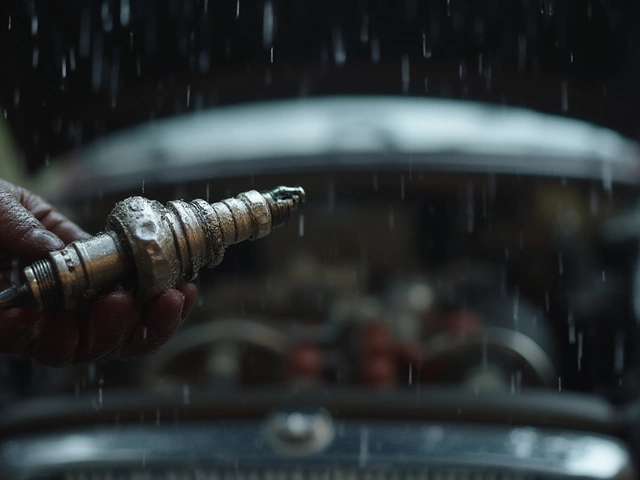Your car feels rough, the check engine light flashes, and now you’re stuck wondering—Is it the spark plug, or is the ignition coil acting up? Tons of people get stumped here. But you don’t have to play the guessing game.
Once you know the tell-tale signs for each culprit, the answer gets way clearer. Misfires, sluggish starts, weird engine noises—these aren’t mysteries. They’re clues. A bad spark plug and a dying coil can act similar at first, but look for details like popping sounds, how your car starts, or even a sudden drop in gas mileage.
You don’t need a wall of tools, either. With a basic socket set and a little know-how, you can spot trouble before calling a shop. I’ll walk you through cause-and-effect, share some DIY detective work, and flag the red-flag symptoms where you really shouldn’t wait.
- What Ignition Coils and Spark Plugs Actually Do
- Top Signs Your Spark Plug Is Toast
- How to Spot a Bad Ignition Coil
- Quick DIY Tests at Home
- Common Mistakes People Make
- When to Replace and How Much It’ll Cost
What Ignition Coils and Spark Plugs Actually Do
If you want your engine to go, you need both the ignition coil and the spark plug firing off in sync. They’re like the tag-team that turns a bit of fuel and air into muscle power. Here’s why they matter.
The ignition coil isn’t just a “part”—it’s the muscle that boosts the car battery’s 12 volts up to tens of thousands. That’s serious voltage. Without that kind of kick, the spark plug would never make a spark strong enough to light the fuel. Think of the coil as the power source, and the spark plug as the match.
Bad ignition coil trouble? Engines stumble or don’t start at all, especially on chilly mornings. Spark plugs, on the other hand, screw right into the engine, right at the heart of the action. They throw the actual spark that kicks off combustion. One of these fizzles out, and you’ll start feeling shakes, losing power, or even missing altogether on one cylinder.
Here’s a quick table to show the difference between the two parts:
| Part | Main Job | Key Sign It’s Bad |
|---|---|---|
| Ignition Coil | Boosts voltage for spark | No spark or weak spark, dead cylinder(s) |
| Spark Plug | Creates spark for combustion | Misfires, poor power, rough idle |
And to make it even clearer, here’s a quote from the experts over at NGK Spark Plugs:
"A worn spark plug or failing coil can cause engine hesitation, loss of power, and poor fuel economy. Both need to be working together for your engine to run its best."
Bottom line: If one is off, your engine won’t be happy—no matter how new the other one is. So when your car’s acting up, pay close attention to these two parts.
Top Signs Your Spark Plug Is Toast
When a spark plug goes bad, your car doesn’t keep it a secret. Spark plugs are simple, but once they’re worn out or fouled, they mess with everything—power, fuel mileage, and even your ability to start the engine.
If you're dealing with any of these signs, don't ignore them:
- Misfiring at idle – The engine sputters or shakes when you’re stopped. You might even feel it vibrate through the steering wheel.
- Hard starts – The engine cranks longer than normal before firing up. Sometimes, it might not start at all, especially on cold mornings.
- Drop in fuel efficiency – You find yourself filling up more often, but you’re not driving further. Bad spark plugs mean incomplete combustion and wasted gas.
- Rough acceleration – Step on the gas and the car hesitates or jerks, especially when climbing hills or merging onto the freeway.
- Poor engine performance – Power just isn’t there like it used to be, especially at high speeds.
- Check engine light – Odds are it’ll flash or stay steady if your spark plug’s given up. Sometimes the code will read P0300, or specify a cylinder like P0302.
A mechanic from CarTalk explains:
“Nine out of ten times, if your car suddenly runs rough and the engine light blinks, it’s a bad spark plug or the wire attached to it. Don’t just ignore it, or you’ll risk frying the catalytic converter.”
Here’s a handy table with the usual lifespan of spark plugs, so you know when to expect trouble:
| Type of Spark Plug | Expected Lifespan (miles) |
|---|---|
| Copper | 20,000 - 30,000 |
| Platinum | 60,000 |
| Iridium | 80,000 - 100,000 |
Tapping the gas and feeling a lag? Your spark plugs could be the reason. Notice a burnt smell or see black soot on old plugs? Swap them. Small risk, big payoff. Faulty plugs can lead to much pricier repairs if left unchecked, like melting a pricey catalytic converter. Don’t wait for all the warning signs—if you tick more than one symptom, it’s time to pop the hood.
How to Spot a Bad Ignition Coil
Catching a bad ignition coil early can save you a pile of headaches and keep your car out of the shop. The coil is what boosts your battery’s voltage to fire up the spark plugs, and when it fails, the whole system can go sideways.
If your car starts stalling, sputtering, or feels jerky—especially when you hit the gas—a bad ignition coil could be the reason. You might notice the engine is harder to start, or you hear loud pops, almost like the exhaust is coughing. Random misfires are another huge tip-off. Ever see your check engine light blinking instead of just staying on? That usually means misfires, and more often than not, a busted coil is the cause.
Take a look at this table with the most common symptoms drivers see when an ignition coil goes bad:
| Symptom | How Often It’s Reported |
|---|---|
| Engine misfire at idle or acceleration | 77% |
| Check Engine Light comes on | 69% |
| Difficulty starting | 54% |
| Poor fuel economy | 47% |
| Loss of power, hesitation | 72% |
If you’re smelling gasoline or rotten eggs, that could also be linked to coil failure because incomplete combustion sends extra fuel through the exhaust. A drop in MPG (miles per gallon) is another clue—drivers sometimes see fuel efficiency tank by 10% or more when coils go bad. If you drive a model with multiple coils (like a coil-on-plug system), failures can even feel random, hitting just one cylinder and making the engine run super rough sometimes but not others.
Quick tip: If your ride is from the 2000s or newer and can read codes, grab an OBD-II scanner. Plug it under the dash and scan for codes like P0301, P0351, or anything that points to misfire or coil circuit issues. These codes make finding a bad ignition coil easy and help you skip most of the guesswork.
Don’t ignore these signs. Ignoring a coil problem can overwork your catalytic converter and cost you a ton more down the line. If your car’s hard to start, runs rough, and the check engine light is going wild, dig into the coils first—even before buying new plugs or sensors.

Quick DIY Tests at Home
You don’t need a fancy garage to figure out if your bad ignition coil or spark plug is the real problem. Most of this stuff just takes a little patience and the right steps. Let’s walk through it.
- Visual Check: Pop the hood and look at the spark plugs and ignition coils. Spark plugs that are black, oily, or just look roasted are likely shot. Coils shouldn’t have cracks, burn marks, or a burnt plastic smell.
- Swap Test: If your car’s misfire is only happening on one cylinder, move that coil or spark plug to another cylinder. If the problem follows the part, you’ve found the troublemaker.
- Listen for a Change: Start the engine and listen. Pull one coil connector at a time (engine off, then restart after each move). When you pull a good one, the engine noise changes. If you pull the bad one, it’ll sound the same—no extra coughing or roughness. Don’t keep the engine running for long with connectors unplugged.
- Check Engine Light Codes: Plug in a cheap OBD-II scanner (most auto parts stores lend these out for free). Codes like P0301 (misfire in cylinder 1) or P0351 (coil 1 issue) make it super clear what’s going on.
- Resistance Test (for coils): Use a multimeter. Take off the suspect coil, touch the leads to the coil’s terminals, and check the reading. Compare to your car manual—the numbers should be close. Way off? The coil is likely toast.
If you want some real-world data, here’s a breakdown of common code meanings and average repair times:
| Code | What It Means | Average DIY Time |
|---|---|---|
| P0300 | Random/Multiple Misfire | 40 min |
| P0301 - P0304 | Misfire (Cylinder 1-4) | 45 min |
| P0351 - P0354 | Ignition Coil (Cylinder 1-4) | 30 min |
Makes sense to swap in new plugs or coils on just the problem cylinder first, but if your car has over 80,000 miles, changing the whole set could save you hassle down the road. Always disconnect the battery before poking around electrical parts. A good socket set, a spark plug gapper, and a ratchet are your main tools here.
Common Mistakes People Make
Plenty of people waste time and money because they misread the signs their car is throwing at them. Let’s set the record straight—these slipups pop up all the time both in home garages and pro shops.
- Mixing up the symptoms: Bad spark plugs and bad ignition coils throw similar signals, like misfires or rough idling. Too many folks swap out coils first—way pricier—when the issue is just a crusty plug.
- Skipping the basics: Sometimes people jump to replacing parts without checking for simple stuff, like a loose wire or an oily plug. Just cleaning the plug or tightening connections can save a ton.
- Ignoring maintenance intervals: Spark plugs and ignition coils both have lifespans. If you haven’t changed spark plugs at the scheduled mileage, that’s usually where to start—don’t ignore your car’s timeline.
- Not using OE (Original Equipment) parts: Cheap, no-name plugs or coils from big box stores can trigger the same problems right after you install them. Stick with brands that match what your car came with.
- Not testing before replacing: Swapping parts without a real diagnosis drains your wallet fast. A simple test—like switching coil positions or checking for a spark—can tell you which part is toast.
Take a look at what mechanics see most often:
| Mistake | Impact |
|---|---|
| Replacing coils when spark plugs are bad | Pays for expensive parts you don’t need |
| Ignoring check engine codes | Problems snowball, leading to breakdowns |
| Overtightening new plugs | Cracks porcelain, damaging new plugs |
| Reusing old spark plug wires | Weak spark, new misfires |
Bottom line: don’t make fixes based on guesswork. Rule out the basics, check the service manual, and don’t skip parts just because they’re “simple.” Even a bad ignition coil can go unnoticed if you don’t pay attention to these slip-ups.
When to Replace and How Much It’ll Cost
Figuring out the right time to swap an ignition coil or spark plug isn’t rocket science. If your car’s misfiring, feels rough when idling, or the check engine light’s been on for more than a day, don’t wait. Ignoring these signs can wreck your catalytic converter or leave you stranded. It’s a lot cheaper to fix a bad ignition coil or spark plug now than to deal with bigger repairs later.
The actual cost depends on your ride—compact, sedan, or SUV—and where you get it fixed. Doing it yourself? Spark plugs are usually cheap. Even top brands like NGK or Bosch are about $6-$15 each, and most cars need four. Ignition coils range from $30 to $90 for most mainstream cars, but some imports or performance vehicles can run $150 per coil. Labor charges at a shop can double that, especially if your engine is hard to reach.
Here’s a quick breakdown so you can budget smart:
| Part | DIY Cost (Each) | Typical Shop Cost Range (All Cylinders) |
|---|---|---|
| Spark Plug | $6–$15 | $100–$250 including labor |
| Ignition Coil | $30–$90 | $200–$600 including labor |
If your car’s past 50,000 miles and you notice slow starting or poor gas mileage, changing the spark plugs is already overdue for most makes. Coils don’t have a set lifespan but fail more with heat and age; if one goes, the rest may not be far behind. A smart move people sometimes miss: if you’re already paying for labor to replace plugs, swapping coils at the same time (especially on higher-mile cars) can save cash in the long run.
Trust your gut and your car’s warning signs. Dragging your feet usually backfires—literally and financially. If you’re not sure what’s failing, most auto parts stores will scan trouble codes for free, which can save you from paying a mechanic just to get a diagnosis.






